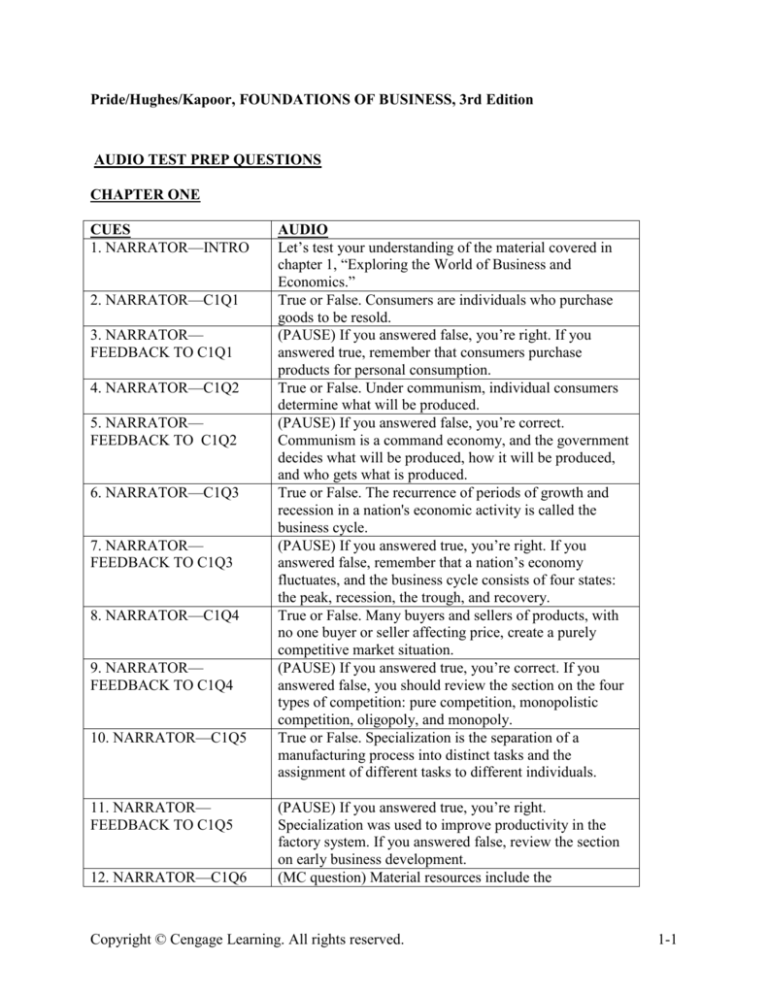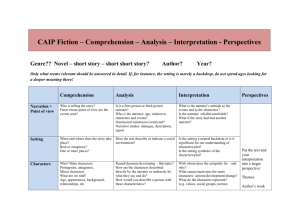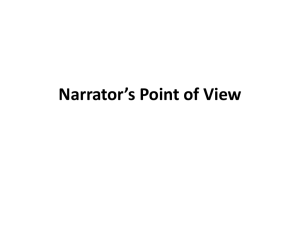
Pride/Hughes/Kapoor, FOUNDATIONS OF BUSINESS, 3rd Edition
AUDIO TEST PREP QUESTIONS
CHAPTER ONE
CUES
1. NARRATOR—INTRO
2. NARRATOR—C1Q1
3. NARRATOR—
FEEDBACK TO C1Q1
4. NARRATOR—C1Q2
5. NARRATOR—
FEEDBACK TO C1Q2
6. NARRATOR—C1Q3
7. NARRATOR—
FEEDBACK TO C1Q3
8. NARRATOR—C1Q4
9. NARRATOR—
FEEDBACK TO C1Q4
10. NARRATOR—C1Q5
11. NARRATOR—
FEEDBACK TO C1Q5
12. NARRATOR—C1Q6
AUDIO
Let’s test your understanding of the material covered in
chapter 1, “Exploring the World of Business and
Economics.”
True or False. Consumers are individuals who purchase
goods to be resold.
(PAUSE) If you answered false, you’re right. If you
answered true, remember that consumers purchase
products for personal consumption.
True or False. Under communism, individual consumers
determine what will be produced.
(PAUSE) If you answered false, you’re correct.
Communism is a command economy, and the government
decides what will be produced, how it will be produced,
and who gets what is produced.
True or False. The recurrence of periods of growth and
recession in a nation's economic activity is called the
business cycle.
(PAUSE) If you answered true, you’re right. If you
answered false, remember that a nation’s economy
fluctuates, and the business cycle consists of four states:
the peak, recession, the trough, and recovery.
True or False. Many buyers and sellers of products, with
no one buyer or seller affecting price, create a purely
competitive market situation.
(PAUSE) If you answered true, you’re correct. If you
answered false, you should review the section on the four
types of competition: pure competition, monopolistic
competition, oligopoly, and monopoly.
True or False. Specialization is the separation of a
manufacturing process into distinct tasks and the
assignment of different tasks to different individuals.
(PAUSE) If you answered true, you’re right.
Specialization was used to improve productivity in the
factory system. If you answered false, review the section
on early business development.
(MC question) Material resources include the
Copyright © Cengage Learning. All rights reserved.
1-1
13. NARRATOR—
FEEDBACK TO C1Q6
14. NARRATOR—C1Q7
15. NARRATOR—
FEEDBACK TO C1Q7
16. NARRATOR—C1Q8
17. NARRATOR—
FEEDBACK TO C1Q8
18. NARRATOR—C1Q9
19. NARRATOR—
FEEDBACK TO C1Q9
20. NARRATOR—C1Q10
A) people who furnish their labor to a business.
B) money required to pay employees and to buy materials.
C) raw materials, buildings, and machinery used in
manufacturing processes.
(PAUSE) If you chose “C”—raw materials, buildings, and
machinery used in manufacturing processes—you’re right.
If you chose another answer, you should review the
section on the definition of business and the four
resources.
(MC question) Fundamental changes occurred in business
ownership and management during the early twentieth
century. Which of the following exemplifies one of those
changes?
A) Ownership was in the hands of thousands of corporate
shareholders who were willing to invest in--but not
operate--a business.
B) The largest businesses were now owned by one
individual.
C) Government took an active role in business
management.
(PAUSE) If you chose “A”—Ownership was in the hands
of thousands of corporate shareholders who were willing
to invest in—but not operate—a business—you’re right. If
you chose another answer, please review the section on
early business development.
(MC question) The commercial airline industry in the
United States would be considered what kind of
competition, due to the sizable investment required to
enter the market and the presence of few market
participants?
A) monopolistic competition
B) oligopoly
C) pure competition
(PAUSE) If you chose “B”—oligopoly—you’re right. If
you chose another answer, please review the section on
types of competition.
(MC question) Kinko's Copy store would be considered a
A) service business.
B) consumer business.
C) manufacturing business.
(PAUSE) If you chose “A”—service business—you’re
right. If you chose another answer, please review the
section on a definition of business.
(MC question) When the Federal Reserve makes decisions
about interest rates, it is influencing
Copyright © Cengage Learning. All rights reserved.
1-2
21. NARRATOR—
FEEDBACK TO C1Q10
22. NARRATOR—SIGN
OFF
A) fiscal policy.
B) the gross domestic product.
C) monetary policy.
(PAUSE) If you chose “C”—monetary policy—you’re
right. If you chose another answer, please review the
section on the business cycle.
That concludes our review of chapter 1. Keep up the good
work. (Good job!) (Great work!)
Copyright © Cengage Learning. All rights reserved.
1-3










